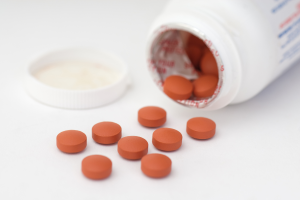Blog
Keeping your Pet safe from Toxins
Potential Household Toxins for Pets
Dogs and cats are notorious for getting into things that they shouldn’t. Sometimes these naughty antics simply lead to a big mess to clean up and other times it can become a serious veterinary emergency. Understanding things that can be toxic or hazardous to your pets helps you to keep them out of reach and keep your pets safe.
Toxins can come in many forms. Medications, foods, plants, and household products can all pose hazards for pet owners. Just like you would child proof your home for a toddler, pet proofing your home for your pets is a great preventative step to keep them safe and healthy.
Medications – It is best to keep ALL medications in a locked cabinet away from your pets. This includes prescriptions, over-the-counter medications, and vitamins. Ibuprofen and acetaminophen are extremely toxic to dogs. Many medications have a sugary type coating on them that can have an attractive smell for pets.
Foods – Some human foods that are safe for our pets, but others can be quite dangerous for them. Many people are familiar with the common dangers such as grapes, chocolate, and onions but there are also many additional foods that are not safe for pets. Some foods that are typically safe, in moderation, for dogs include carrots, apples, spinach, and pumpkin. We recommend feeding your pets their regular diet and keeping these dangerous foods(1) out of their reach.
Plants – Many plants are harmful to pets. The list is so extensive that we recommend you look up individual plants before you bring them into your homes or gardens. Chewy has a helpful list of plants to avoid such as lily of the valley, tulip, and rhododendron (5).
In addition to plants that are toxic for our house pets, there are also plants that are harmful for livestock and horses such as red maple. The Penn State Extension has a great list of plants toxic for horses(2).
Household products – In addition to edible threats in your home, there are also potentially many non-edible items that can be dangerous for your pets. Some of the non-edible threats include cleaning products, antifreeze, and paints (3,4). Even products labeled as non-toxic should be kept out of the reach of pets.
If you think that your pet has gotten into something dangerous, we recommend that you call your veterinarian right away to ask them what they recommend you do. Your vet might tell you to keep a close eye on your pet and monitor for signs of ingestion, or they might have you bring them into the clinic right away for treatment.
resources:
https://www.aspcapro.org/resource/top-10-pet-toxins-2022
https://be.chewy.com/complete-guide-to-poisonous-plants-for-dogs/ (5)
https://be.chewy.com/air-purifying-plants-safe-for-dogs-cats/
https://extension.psu.edu/plants-toxic-to-horses (2)
https://bluegrassanimalproducts.com/2021/11/17/what-can-my-dog-eat-on-thanksgiving/
https://www.fda.gov/animal-veterinary/animal-health-literacy/potentially-dangerous-items-your-pet (3)
https://www.petmd.com/poisoning/cleaning-products-that-harm-pets (4)




